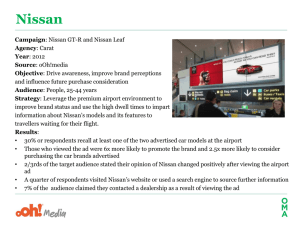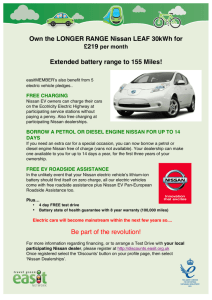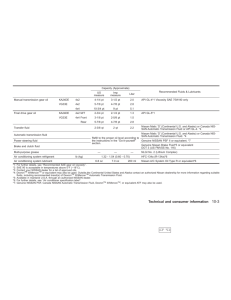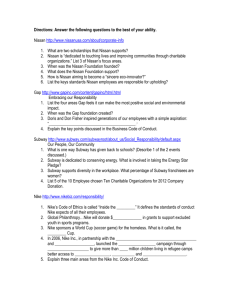Nissan - Clean Energy Ministerial
advertisement
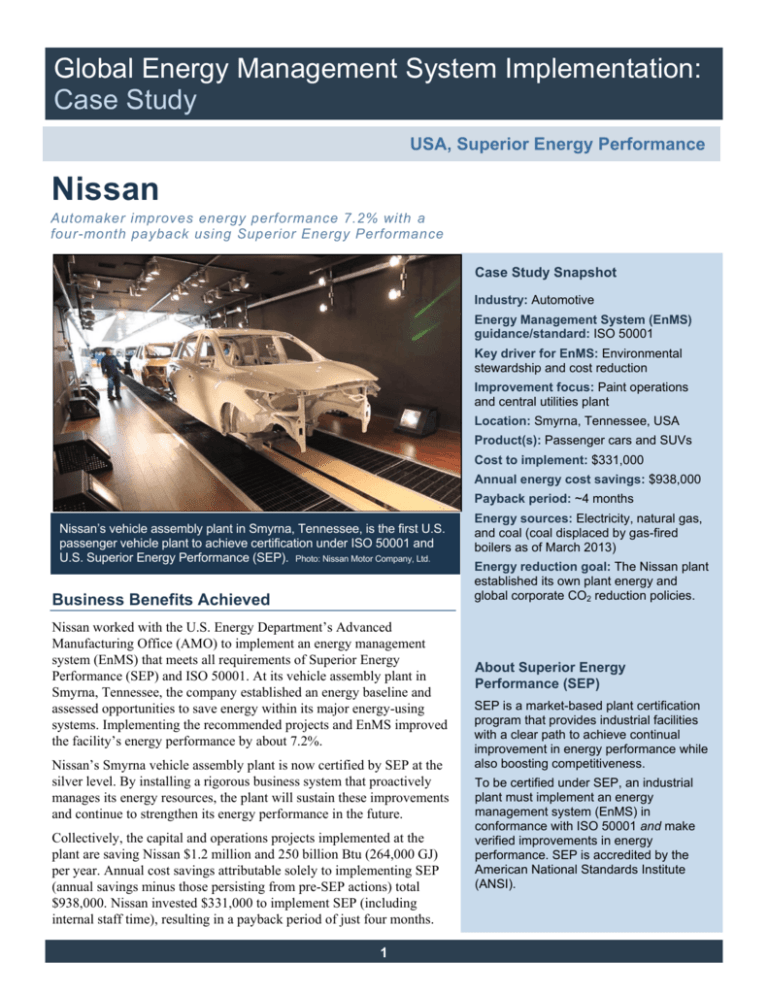
Global Energy Management System Implementation: Case Study USA, Superior Energy Performance Nissan Automaker improves energy performance 7.2% with a four-month payback using Superior Energy Performance Case Study Snapshot Industry: Automotive Energy Management System (EnMS) guidance/standard: ISO 50001 Key driver for EnMS: Environmental stewardship and cost reduction Improvement focus: Paint operations and central utilities plant Location: Smyrna, Tennessee, USA Product(s): Passenger cars and SUVs Cost to implement: $331,000 Annual energy cost savings: $938,000 Payback period: ~4 months Nissan’s vehicle assembly plant in Smyrna, Tennessee, is the first U.S. passenger vehicle plant to achieve certification under ISO 50001 and U.S. Superior Energy Performance (SEP). Photo: Nissan Motor Company, Ltd. Business Benefits Achieved Nissan worked with the U.S. Energy Department’s Advanced Manufacturing Office (AMO) to implement an energy management system (EnMS) that meets all requirements of Superior Energy Performance (SEP) and ISO 50001. At its vehicle assembly plant in Smyrna, Tennessee, the company established an energy baseline and assessed opportunities to save energy within its major energy-using systems. Implementing the recommended projects and EnMS improved the facility’s energy performance by about 7.2%. Nissan’s Smyrna vehicle assembly plant is now certified by SEP at the silver level. By installing a rigorous business system that proactively manages its energy resources, the plant will sustain these improvements and continue to strengthen its energy performance in the future. Collectively, the capital and operations projects implemented at the plant are saving Nissan $1.2 million and 250 billion Btu (264,000 GJ) per year. Annual cost savings attributable solely to implementing SEP (annual savings minus those persisting from pre-SEP actions) total $938,000. Nissan invested $331,000 to implement SEP (including internal staff time), resulting in a payback period of just four months. 1 Energy sources: Electricity, natural gas, and coal (coal displaced by gas-fired boilers as of March 2013) Energy reduction goal: The Nissan plant established its own plant energy and global corporate CO2 reduction policies. About Superior Energy Performance (SEP) SEP is a market-based plant certification program that provides industrial facilities with a clear path to achieve continual improvement in energy performance while also boosting competitiveness. To be certified under SEP, an industrial plant must implement an energy management system (EnMS) in conformance with ISO 50001 and make verified improvements in energy performance. SEP is accredited by the American National Standards Institute (ANSI). Global Energy Management System Implementation: Case Study USA, Superior Energy Performance Company Profile Cost-Benefit Analysis Nissan is a world leader in the automotive business. The company operates three manufacturing facilities in the United States, two of which are in Tennessee and the other in Mississippi. The Smyrna plant is the largest of the three, producing Nissan’s Altima, Maxima, Xterra, Frontier, and Pathfinder models during the period covered by this case study. [Since September 2012, the Nissan LEAF and Infinity JX have replaced the Xterra and Frontier models in production at the facility.] While Nissan’s global corporate headquarters are in Yokahama, Japan, its U.S. branch, known as Nissan North America, Inc., is based in Franklin, Tennessee. This case study focuses solely on Nissan’s vehicle manufacturing and assembly operations in Smyrna; it excludes energy used for lab testing, transportation, and emergency backup generators. Business Case for Energy Management Although Nissan’s energy costs represent only 3.3% of total manufacturing costs, corporate goals and customer expectations drive its strong commitment to energy efficiency. Nissan’s corporate Green Program 2016 promotes sustainability and sets ambitious environmental goals—reinforcing the company’s reputation as a responsible steward of the environment. The Green Program aims to reduce CO2 emissions by 20% across all Nissan manufacturing facilities by 2016 (based on tonnes of CO2 per vehicle compared to fiscal year 2005). The U.S. branch is pursuing this goal by making operational improvements, which typically require little or no capital investment, as well as technical improvements (capital projects). The Green Program’s focus on reducing CO2 emissions provides an internal management performance indicator to drive efficiency improvements by 2016. The cost savings that can be achieved by implementing an EnMS provide another important driver. A further motivation for Nissan’s energy efficiency efforts is to set an example for the companies in its vast supply chain. Nissan’s innovative supply chain partnership program requires suppliers to demonstrate their commitment to energy efficiency, and Nissan understands the value of leading by example or “walking-the-walk” within its own operations. Cost-Benefit Analysis A detailed analysis quantified the costs and benefits associated with implementing SEP/ISO 50001 at the Smyrna plant. The analysis considered all program costs, including staff time (existing employees). To help isolate the impacts of energy efficiency measures, the 2008 baseline was adjusted to align with production and operations during the impact reporting period (see timeline on next page). Energy and cost savings were then calculated using utility data. This analysis shows that the plant’s $331,000 investment in no-cost and low-cost actions to improve energy performance saves $938,000 per year, paying back the 2 COSTS, SAVINGS, AND PAYBACK Total Cost for Implementing SEP $331,000. Internal Plant Staff Time (subtotal) EnMS Development and SEP Data Collection SEP/ISO 50001 Audit Preparation $250,000. $219,000. $31,000. External Costs (subtotal) External Technical Assistance EnMS Monitoring and Metering Equipment SEP/ISO 50001 Audit (3rd party auditor) $81,000. $44,000. Total Annual Energy Savings (Attributable to SEP) Annual Operational Improvement Energy Savings (Attributable to SEP) Annual Capital Project Energy Savings (Attributable to SEP)1 $938,000. SEP Marginal Payback2 $21,000. $16,000. $938,000. $0. ~4 months 1 Capital projects occurred prior to the start of the SEP Training period, which demarcates pre- and post-SEP actions. 2 SEP marginal payback is based on operational energy cost savings attributable to SEP program and not on capital projects. Global Energy Management System Implementation: Case Study USA, Superior Energy Performance investment in just four months. The Smyrna plant is expected to retain these savings over time—through ongoing use of the EnMS. Nissan Smyrna Facility SEP Timeline Energy Management System Implementation Nissan’s commitment to energy efficiency started well before its adoption of the EnMS. In 2006, Nissan became a partner in the ENERGY STAR® program and established the Nissan North America Energy Team to achieve corporate energy reduction goals in its U.S. region. This cross-functional team is led and supported at the executive level by Nissan’s Sr. Vice President and Director/Plant Manager. This executive-level support has been critical to the success of Nissan’s energy efficiency efforts. The team, which meets weekly, is drawn from every level of management, including the production, maintenance, legal, facilities engineering, corporate communications, purchasing, finance, environmental, and contract services departments. Nissan’s Energy Team, with support from the Facilities Engineering department at the plant, modeled the EnMS after its existing management system for the environment (ISO 14001). Nissan’s management system for quality (ISO 9001), as well as prior work with the ENERGY STAR® program, also provided valuable experience during EnMS implementation. Nissan’s Smyrna facility then developed an energy management policy (nationally applicable), set objectives for improving its energy performance, developed an energy profile for the site, and calculated its energy baseline (2008). Plant staff implemented and commenced use of the EnMS over nine months from July 2010 to March 2011. Nissan subsequently conducted an internal audit and management review of the EnMS energy impacts in preparation for the third-party audit that certified the facility under both ISO 50001 and SEP in May 2012. Managing Energy Better Nissan’s Smyrna plant has used a sophisticated sub-metering system since 2006, thanks to a senior management initiative to reduce energy use and a well-executed data visualization project that made the data accessible to everyone. Nissan upgraded the system in 2010 in preparation for SEP’s rigorous verification process. To better measure, calibrate, and verify energy consumption values, the sub-metering system was retrofitted so that significant energy uses in the plant were connected to robust calibration and verification matrices. In addition, Nissan invested $21,000 in 2011 to monitor newly installed equipment and processes that use significant amounts of energy. Although in its infancy, the EnMS has helped plant personnel recognize how their own actions affect energy use. The system has also prompted Nissan to closely consider the energy impacts of new design projects and facility or equipment modifications. Nissan plans to continue using the EnMS at its Smyrna plant and extend energy management to its other facilities. 3 SEP certification requires a facility to set an energy baseline, establish an energy team, identify and pursue energy-saving measures, and achieve verified energy savings between the baseline and reporting period. The cost-benefit analysis that arrived at the four-month payback (presented on the preceding page) considered only those savings achieved as a direct result of operational improvements. Global Energy Management System Implementation: Case Study USA, Superior Energy Performance Energy Savings Assessments Nissan’s Smyrna plant participated in three energy savings assessments led by Oak Ridge National Laboratory with funding from the U.S. Energy Department. These assessments focused on the plant’s process heating, compressed air, and pump systems to identify the most cost-effective opportunities to save energy. The largest potential for savings was identified in the process heating system. On the basis of these assessments, Nissan identified and implemented various capital projects in 2009, which Personnel from companies participating in the SEP demonstration facility program, including members of the Nissan North America Energy Team. included modifying boiler controls, Photo: Nissan Motor Company, Ltd. replacing piping insulation, upgrading compressed air controls, and improving miscellaneous pumping systems. Building on these successes, the company continues to identify energy-saving opportunities through ongoing use of its EnMS. Energy Profile To measure and track improvements achieved across the facility, Nissan used the DOE energy performance indicator (EnPI) tool, which provides a plant-wide energy profile. Effective use of this tool requires a thorough knowledge of the factors that affect a plant’s energy intensity and the ability to use statistical techniques to analyze and normalize data. Nissan’s staff attended training in these techniques, then developed historical EnPIs for the Smyrna plant as required for SEP certification. The Smyrna plant’s biggest energy user is its vehicle painting process, which consists of three paint shops: one for cars, one for trucks, and one for fascias (front headlight/bumper panels). The three paint shops, which consist primarily of paint booths and ovens, consume around 70% of the plant’s total energy, suggesting large potential for improvement. Internal and Third-Party Audit and Certification Nissan’s Energy Team conducted an internal audit to prepare for the third-party verification of its energy savings. As Nissan was already familiar with internal audits from its experience with ISO 9001 and 14001, completing the internal audit for ISO 50001 was a familiar exercise. Where the requirements of various ISO programs overlap, Nissan recognized opportunities to adjust or realign activities to avoid duplication of effort (e.g., CO2 reduction goals under ISO 14001 align well with energy management criteria under ISO 50001). The Phase I or “readiness review” audit, which is the first of two SEP certification stages, involves offsite review of the energy savings model, internal audit results, and major energy projects and energy uses, as well as a management review. Depending upon the timing of requirements 4 “SEP adds rigor, analysis, and gives good guidance. It’s one thing to have a target and objective, but SEP gives tools that empower you to be more disciplined and prove the impact certain activities have.” -Nissan North America Energy Team Global Energy Management System Implementation: Case Study USA, Superior Energy Performance for other certification programs and corporate initiatives, the interval between Phases I and II of the third-party SEP verification process can be extremely busy for plant staff. The Nissan team met this workload challenge and the SEP and ISO 50001 audits successfully verified an energy performance improvement of 7.2%, qualifying Nissan for SEP certification at the silver level (achieved energy performance improvement between 5% and 10%). Nissan’s Smyrna vehicle assembly plant had already improved its energy performance 7.2% over the base year at the time of the SEP energy performance verification audit, qualifying the plant for SEP certification at the silver level. Barriers, Lessons Learned, and Results Barriers Nissan management understands the value of energy efficiency improvements, yet the finite funds available to invest in energy efficiency each year must compete for priority with other important business drivers (quality, new program models, etc.). Investments in operational and capital projects must also be justified in payback increments of no more than one to three years, a range ubiquitous across the automobile industry. To justify projects at the Smyrna plant, proposals are submitted for global funding consideration. They are ranked and ultimately selected globally, based on available funding, payback, and level of projected CO2 reduction. Shifting the culture and convincing plant officials to invest in energy efficiency initially posed a major challenge. Some believed the company had already seized all opportunities to reduce energy usage; however, the EnMS and the EnPI tool enabled discovery of correctable, previously undetected energy losses. For example, the Nissan Energy Team reexamined practices at the central chiller plant and identified nocost measures that delivered over $67,000 in annual energy savings. The Nissan Energy Team faced additional challenges throughout the energy management implementation process. For example, adjustments to the baseline complicated the analysis of energy performance and significant effort was needed to distinguish the effects of changing the computer models from energy impacts of manufacturing activities. Superior Energy Performance Levels: All facilities must meet a minimum energy performance improvement within three years after the baseline period. Silver: 5% Gold: 10% Platinum: 15% “SEP is worth the effort as it brings structure and discipline to the program. Nissan values third-party validation and the external recognition for being an environmentally friendly manufacturer.” Nissan North America Energy Team Lessons Learned When developing energy action plans to achieve energy savings targets, Nissan found it extremely important to develop a strong measurement plan that can help to ensure implementation and verify results. Prior to SEP, Nissan primarily used its sub-metering data to allocate costs among departments. The SEP requirement to identify savings related to 5 Global Energy Management System Implementation: Case Study USA, Superior Energy Performance specific actions or projects helped the plant make constructive use of this data. Nissan also learned that extensive sub-metering makes it much easier to verify and quantify the results of energy conservation measures. It allows staff to make process or equipment-specific “sanity” checks from the bottom up to verify overall, top-down energy savings. Multi-linear regression models such as the EnPI tool have proven to be excellent instruments for analyzing energy savings and achieving continuous improvement in complex manufacturing plants, such as the Smyrna plant. Nissan has expanded the EnPI tool for use in various shops and processes within the Smyrna plant—outside the scope of the initial EnMS. The plant can now successfully analyze, track, and compare energy performance to help meet CO2 reduction targets. Energy savings from operational improvements differ from capital equipment savings in that continuous discipline is needed to execute and monitor the necessary actions. An EnMS provides this discipline. When integrated into a plant’s normal business systems, measures to improve operations can effectively sustain valuable energy savings. Results Nissan’s Smyrna plant improved its energy efficiency by 7.2% (from the baseline period to the reporting period) and attained SEP status as a Silver Certified Partner. The energy efficiency measures implemented by Nissan save 250 billion Btu (264,000 GJ) and $1.2 million in costs annually. Savings attributable to SEP make up $938,000 of the annual savings. The plant’s participation in the SEP program demonstrates that large plants can reap large benefits by implementing an energy management system. Nissan currently plans to pursue SEP certification for Smyrna’s sister plant in Mississippi, as well as for its powertrain plant in Tennessee. SEP is also being considered for Nissan’s plants in Mexico. Nissan enjoys the respect and recognition it has earned through its energy management and SEP certification. The company is keen on continuing to communicate the importance of energy management to its customers and suppliers. Achieving continuous improvements in environmental performance and the efficient use of energy and other resources is a core value reflected in Nissan’s corporate structure and environmental philosophy: “Toward the symbiosis of people, vehicles and nature.” Keys to Success Extensive sub-metering adds value and enables the plant to conduct bottom-up energy consumption analysis. This equipment is used to verify energy savings specific to an individual process or piece of equipment. SEP provides rigor, analysis, and guidance throughout the energy management implementation process. It provides an energy savings target that drives the level of effort. Tools provided by SEP empower the plant to be more disciplined and prove the impacts of specific activities or projects. The EnPI tool is useful for discovering hidden energy waste and other low/no cost improvement areas. Nissan found that developing a strong measurement plan during the energy management development stage was extremely helpful in verifying results. “More companies should be interested in third-party verification. We can now prove our savings. The SEP process is much more disciplined and removes extraneous factors.” Nissan North America Energy Team The Global Superior Energy Performance (GSEP) initiative was launched in 2010 by the Clean Energy Ministerial (CEM) and International Partnership for Energy Efficiency Cooperation (IPEEC). Through GSEP’s Energy Management Working Group (EMWG), government officials worldwide share best practices and leverage their collective knowledge and experience to create high-impact national programs that accelerate the use of energy management systems in industry and commercial buildings. For more information, please visit http://www.cleanenergyministerial.org/energymanagement 6
